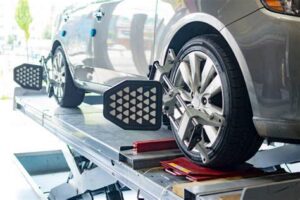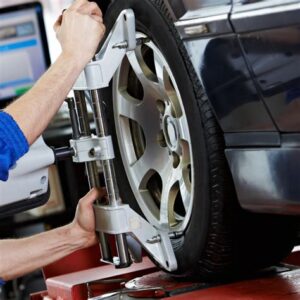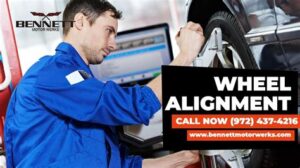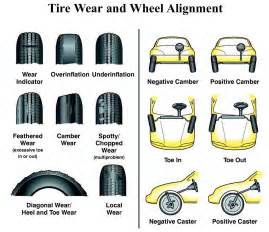Discover common signs of tire issues, including uneven wear, pulling to one side, vibrations, off-center steering, and squealing. Ensure safe driving today!Regular vehicle maintenance is essential for ensuring a smooth and safe driving experience, and one crucial aspect that often gets overlooked is wheel alignment. Misalignment can lead to a variety of issues that not only affect your car’s performance but also compromise your safety on the road. Are you suspicious that your car might be in need of alignment? This blog post will guide you through the telltale signs to watch for, including uneven tire wear, your vehicle pulling to one side, and unusual vibrations in the steering wheel. Additionally, we’ll explore the implications of an off-center steering wheel and the irritating squealing of your tires. By the end of this post, you’ll have a clearer understanding of alignment issues and when it’s time to seek professional assistance. Let’s dive in!
Uneven Tire Wear
One of the first indicators that your car may need an alignment is uneven tire wear. When your tires are misaligned, they wear down at different rates, leading to a noticeable difference in tread depth across the tire surfaces. This can substantially affect handling and safety.
For instance, if the inside or outside edges of your tires are more worn than the rest, it’s often a clear sign that your vehicle’s alignment is off. Additionally, if you check your tires and find that the front tires are wearing down faster than the rear tires, this discrepancy can indicate misalignment issues. Regularly monitoring your tire condition can help catch these problems early.
To properly assess uneven tire wear, you should inspect your tires at least once a month. Use a tire tread depth gauge to measure the tread on various parts of each tire. If significant differences are found, it’s advisable to have a professional alignment check as soon as possible to prevent further damage and ensure safe driving.
Vehicle Pulls to One Side
If you notice that your car tends to pull to one side while driving, it can be a clear indication that your vehicle may need alignment. This issue can be quite dangerous as it can affect your control over the vehicle and lead to issues such as uneven tire wear.
Several factors may contribute to your car pulling to one side, including misalignment of the wheels, uneven tire pressure, or even damaged suspension components. Regular alignment checks can help prevent these issues from worsening.
To address this issue, the first step should be inspecting the tire pressure. Ensure all tires are inflated to the manufacturer’s specifications. If the tire pressure is good, it’s advisable to have a professional examine your vehicle for any alignment problems. Wheel alignment can help make your vehicle drive straight and improve tire longevity.
Steering Wheel Vibrations
If you’ve ever experienced steering wheel vibrations, you may have wondered if this is a sign that your car needs alignment. These vibrations can be quite unsettling, and they may indicate underlying issues that need attention.
One common cause of steering wheel vibrations is improper wheel alignment. When your wheels are not aligned correctly, it can cause them to tilt at odd angles, leading to uneven tire wear and vibration. This is not only uncomfortable but can also compromise your vehicle’s handling and safety.
Other factors that may contribute to steering wheel vibrations include unbalanced tires, damaged suspension components, or worn-out tie rods. If you notice that your steering wheel shakes at certain speeds or under specific conditions, it’s crucial to have a professional mechanic inspect your vehicle. Regular maintenance and alignment checks can help prevent these issu
Off-Center Steering Wheel
An off-center steering wheel is one of the most noticeable signs that your vehicle may be in need of alignment. This condition occurs when your steering wheel is not perfectly aligned with the wheels of your car, which can be both frustrating and concerning for drivers.
When you are driving straight and your steering wheel is tilted to one side, it indicates that your vehicle’s wheels are not pointing in the same direction. This misalignment can be caused by a variety of factors, including hitting a pothole, curb damage, or even normal wear and tear over time. Ignoring this issue can lead to further complications, including uneven tire wear and increased difficulty in steering.
To check if your steering wheel is off-center, take your car to a safe, flat area. Drive in a straight line and see if the steering wheel sits at an angle. If it does, it’s advisable to have your alignment inspected by a professional. Maintaining proper wheel alignment is essential for safe driving and prolonging the life of your tires.
Squealing Tires
One of the most alarming signs that your vehicle may need alignment is squealing tires. This noise often indicates that the tires are improperly positioned and are rubbing against the roadway or other components of the vehicle. Squealing may also suggest that the tires are experiencing uneven wear, stemming from misalignment. You should pay close attention to this sound, as it can lead to further tire damage if not addressed promptly.
There are various reasons why your tires might be squealing. If your car’s wheel alignment is off, it can cause the tires to wear unevenly, resulting in a squealing noise as the tread struggles against the pavement. Similarly, if your tires are over-inflated or under-inflated, they may also create this unwelcome sound. As a preventative measure, checking your tire pressure regularly can enhance overall performance and longevity.
If you notice squealing tires, it is wise to consult a professional mechanic. They can perform an alignment check and determine if there are underlying issues. Ignoring the problem may lead to other complications, such as decreased fuel efficiency or an inability to maintain control of your vehicle. Taking early action can save m
Frequently Asked Questions
What are the signs that my car needs alignment?
Common signs include uneven tire wear, the steering wheel being off-center, the car pulling to one side, and a vibration in the steering wheel.
How often should I check my car’s alignment?
It’s recommended to check your car’s alignment every 6,000 miles or at least once a year, but you should also have it checked regularly if you’ve hit a pothole or curb.
Can misalignment affect my fuel efficiency?
Yes, misalignment can cause your vehicle to work harder, resulting in decreased fuel efficiency.
Is it safe to drive a car with misaligned wheels?
Driving a car with misaligned wheels can be unsafe as it may affect handling and lead to further tire and suspension issues.
What will a mechanic do during a wheel alignment service?
A mechanic will adjust the angles of the wheels to the manufacturer’s specifications, often checking and adjusting the camber, caster, and toe.
How does tire pressure affect wheel alignment?
Incorrect tire pressure can lead to uneven tire wear, which might be mistaken for misalignment or can exacerbate existing alignment issues.
How much does a wheel alignment typically cost?
The cost of a wheel alignment can vary but generally ranges from $75 to $100, depending on the location and vehicle type.





